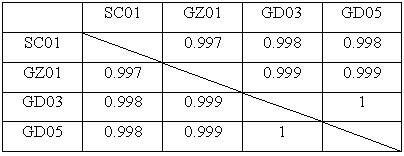Primers for determining full-gene sequence of influenza A H1N1 viruses and determination method
A technology of influenza virus and determination method, which is applied in the field of primers and kits for determining the complete gene sequence of influenza A (H1N1) virus, which can solve the problems of poor primer specificity, low sensitivity, and influence on the determination and monitoring of the entire gene sequence of influenza A (H1N1) virus progress and other issues, to achieve the effect of simple sampling, high sensitivity and stable results
- Summary
- Abstract
- Description
- Claims
- Application Information
AI Technical Summary
Problems solved by technology
Method used
Image
Examples
Embodiment 1
[0030] Example 1: Design of primers and probes
[0031] By comparing and analyzing the gene sequences of 100 known A / H1N1 virus strains in all GenBank databases, a highly conserved segment was selected, and 48 pairs of primers and probes were designed, as described in SEQ ID NO: 1-96. The principles of primer design are as follows:
[0032] (1) The length of the primer is about 20-23nt, and the GC content is between 45%-55%.
[0033] (2) The length of PCR amplification is generally between 400-600 bp.
[0034] (3) For the same template fragment, design primers so that each site is covered by 2-3 PCR amplified fragments, so as to avoid point mutations in the PCR reaction from affecting the interpretation of the results.
[0035] Analyze the information of the above-mentioned virus-specific genes, and use the sequence analysis software DNASTAR to exclude inter-primer / inner dimers, and verify the specificity of the primers and the homology of similar pathogens by BLAST, and des...
Embodiment 2
[0036] Embodiment 2: Construction and optimization of PCR reaction system
[0037] 1. Sample Collection
[0038] Our laboratory collected samples from three suspected cases on May 17 and May 28, 2009, including the first suspected imported H1N1 case in Guangdong Province and the first and second second-generation suspected cases of H1N1 in my country Nasal / throat swab specimens of Dai and Xue.
[0039] 2. Extraction of RNA from nasal / throat swab specimens
[0040] Use the QIAmp MiniElute Virus Spin Kit (Qiagen, Chatsworth, CA) to extract RNA from nasal / pharyngeal swab specimens, and follow the instructions:
[0041] (1) When using this kit for the first time, add 100% ethanol to the AW1 and AW2 buffers according to the volume indicated on the reagent bottle, add 25 ml absolute ethanol to 19 ml AW1, add 30 ml absolute ethanol to 13 ml AW1 Ethanol; add 28 μg / ml carrier RNA to AL.
[0042] (2) Put 25 μl Qiagen Protease into a 1.5 ml centrifuge tube.
[0043] (3) Add 200 μl of...
PUM
 Login to View More
Login to View More Abstract
Description
Claims
Application Information
 Login to View More
Login to View More - R&D
- Intellectual Property
- Life Sciences
- Materials
- Tech Scout
- Unparalleled Data Quality
- Higher Quality Content
- 60% Fewer Hallucinations
Browse by: Latest US Patents, China's latest patents, Technical Efficacy Thesaurus, Application Domain, Technology Topic, Popular Technical Reports.
© 2025 PatSnap. All rights reserved.Legal|Privacy policy|Modern Slavery Act Transparency Statement|Sitemap|About US| Contact US: help@patsnap.com



